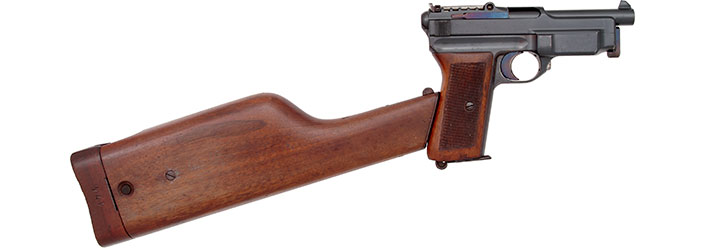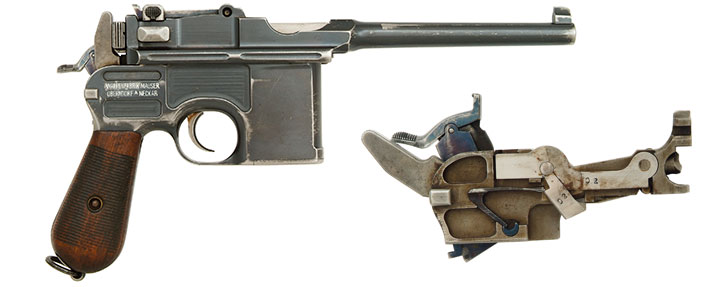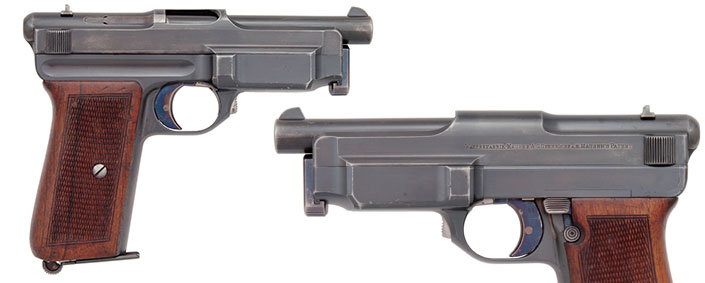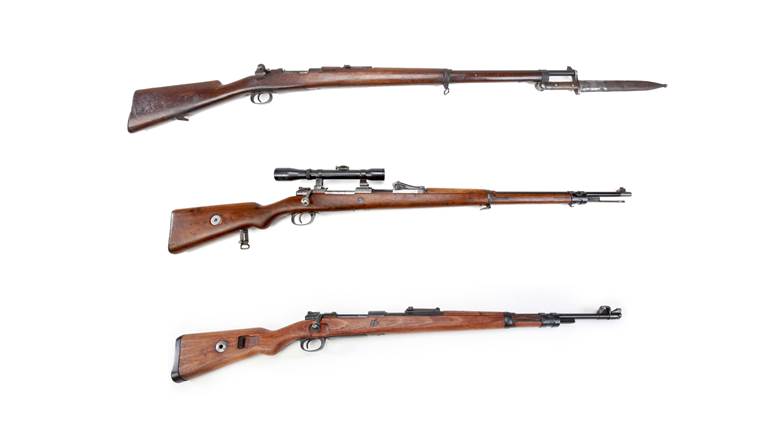
We all know that the course to success is never easy and doesn’t come overnight. It doesn’t matter whether the focus is education, athletic achievement, diplomatic accord or commercial profitability; success requires tremendous perseverance. As Thomas Edison once said, “Genius is one percent inspiration, ninety-nine percent perspiration.”
While one could certainly argue that Mauser worked with a more favorable ratio, finished products never “fell off the shelf.” Every model had to be designed, built and tested—an expensive process that was often fraught with pitfalls, dead ends and abject failures. It is human nature that no one likes to remember this part of the equation. But, by studying the failures and iterative improvements, we can best appreciate the work of Paul Mauser, Josef Nickl and Alex Seidel—just a few of Mauser’s extraordinary designers who conceived some of the finest firearms in the world.

One of the most iconic of Mauser’s pistols is the C96 Broomhandle. While credit for its design remains in dispute (Paul Mauser vs. the Federle brothers), there can be no argument that Mauser made more than a million C96s in a variety of configurations. The gun was incredibly successful and was powerful, durable and very charismatic. Yet, as one might suspect, the C96 didn’t reach its final form overnight. The very first pistols were markedly different from later guns in having a distinct step between the large-diameter chamber and the smaller, untapered barrel. The majority were marked “SYSTEM MAUSER” on top of the chamber, had solid rails, a single-lug locking block and checkered stocks. Most later pistols, beginning with serial number 200, had the more familiar tapered barrel, fluted rails, a two-lug locking block and serrated stocks.
From the beginning, the C96 was offered in six-shot, 10-shot and 20-shot versions. From a collector’s standpoint, the rarest and most striking guns were the 20-shots made with an integral magazine. Mauser made about 75 milled-panel guns that appeared in three variations, depending on the details specific to a particular serial range. They were all matched to an unusually large shoulder stock whose body was made from a single piece of European walnut. Despite their tremendous “curb appeal,” these large, unwieldy and frankly cumbersome guns saw little, if any, actual use. In this case, Mauser didn’t really care, for their ostentatious presentation gave new meaning to the words “pride of ownership.”

At the same time, Mauser also made a limited number of C96 carbines, sequentially numbered in a separate range from 1-1100 (approximately), whose main features underwent the same evolutionary improvements as the pistols. As one might expect, the first 30 carbines were Conehammers, most having an 11 7⁄8" heavy ribbed barrel, a pinned 50-500-meter rear sight and flat rails. Seen as a rich man’s toy, few were sold and even fewer now survive, explaining their desirability, particularly among hardcore collectors.
One of the C96’s features that Paul Mauser seemed to perennially address was the safety, whose form changed several times during the gun’s production. Aside from the usual and well-established configurations on the frame’s left, Mauser delved into two short-lived explorations. In 1902, Mauser patented a “jointed hammer safety” for more convenient, one-handed cocking. Rotating the safety forward blocked the hammer from hitting the firing pin. To fire, the safety had to be pulled back and locked to the rear. Complex and awkward, only a few guns were fitted with this mechanism, examples having been recorded from 28XXX-50XXX.

In 1905, Mauser designed another safety. In this case, a small projection extended from the left side of the hammer to act upon a reciprocal lug on the safety lever. If the safety was applied with the hammer down, cocking the hammer would automatically cam the safety into the “off” position. If applied while the hammer was cocked, the hammer could not be dropped. Although an improvement over the 1902 hammer safety, there was so little added advantage compared to the existing design that it, too, remained in the experimental category.
As an aggressive manufacturer, Mauser was continually designing new products. One of the most interesting pistols was the Model 1906-08 chambered for the 9x21 mm cartridge, often referenced as the 9 mm Export. Approximately 100 of these guns were assembled, sequentially numbered in an independent range from 1-100. This was the first Mauser pistol to have a detachable magazine in front of the grip, and the first to have the flap-locked, action-retarding mechanism. Even though the Model 1906-08 was never introduced commercially, the design effort was far from a failure, for its features were carried forward to the Model 1910 in .45 ACP, the Model 1912-14 and the Model 1915 Flieger carbine and rifle.

Although Mauser did not participate in the U.S. military pistol trial of 1907, the firm was keenly aware of the .45 ACP cartridge, and experimented with a series of delayed-blowback pistols. Several lines of development were pursued independently, each numbered in a separate serial range. The first .45 ACP guns had a forward frame buffer, a vertically dropping, action-retarding block and a sidelatch to access the firing mechanism. To streamline production, Mauser dispensed with the frame buffer and eliminated the sidelatch. Inadequate to manage the recoil, this design was quickly eliminated. Mauser’s third attempt to make a reliable pistol for the .45 ACP placed a pair of horizontally rotating, retarding flaps in the forward frame. That was the same concept as previously implemented in the Model 1906-08 and set the stage for the Model 1912-14s.

To the casual observer, the 9 mm Parabellum Model 1912-14 might appear as a Model 1910 in 6.35 mm (.25 ACP) “on steroids.” Yet, nothing could be further from the truth. A scarce pistol, Mauser manufactured fewer than 200 Model 1912-14s in a variety of configurations. The earliest guns had a conventional-appearing slide with a hand-engraved three-line address. The serrated area was soon elevated for better grasping after which the markings transitioned to a two-line address. Most Model 1912-14s were marked with a single line, die-rolled legend. Minor changes were directed to the forward frame and a few guns, usually with a serial number above 100, were assembled with matching shoulder stocks. All of them were numbered in a separate, sequential serial range and considered experimental guns. Toward the end of the Model 1912-14 production, Mauser completed a handful of shoulder-stocked guns with tangent rear sights. Known as the “Armee Pistole,” a few were reportedly sent to the Brazilian navy in 1913; others were used for commercial promotion. Recorded serial numbers, intermixed with standard-production guns, are in the range 141-174.

Following the death of Paul Mauser in 1914, Mauser’s development program was taken over by Josef Nickl. One of the first full-size pistols to have his well-known rotating barrel system was a Model 1915, No. 2, dated “17.2.1915” for Feb. 17, 1915. Soon afterward, Nickl came out with a simplified series of rotating-barrel guns chambered in 7.65 mm Browning (.32 ACP), 9 mm Kurz (.380 ACP), 9 mm Parabellum (9 mm Luger) and .45 ACP. Fewer than 100 were completed for internal review. Seemingly poised for introduction, the project was halted. Just why Mauser pushed this effort aside remains unclear, as hundreds of thousands of pistols based on the same design were sold under license by CZ as the Model 1922, and were followed by the Model 1924 and Model 1927.
Toward the end of World War I, Mauser assembled a small number of Model 1917 Trench Carbines. Hoping to interest the German military in a new arm for close-quarters combat, the gun was based on the C96 action, chambered for 9 mm Parabellum, and sequentially numbered from 1-40. Although the surviving examples differ in chamber markings, hammer design, trigger guard configuration and barrel length, all were made to hold a detachable magazine. Capacities varied, with the most impressive being a stick magazine holding 40 cartridges. But the Mauser was deemed too expensive to replace the stocked Luger with snail drum magazine (already in service with the German army), so the project was abandoned. Given the ravages of time, only a few guns survived.

Many years later, in the early 1930s, Mauser decided to create a family of pistols related to the HSc. Simply supersizing the HSc for 9 mm Parabellum was impractical, for the blowback pistol could not handle the more powerful cartridge. So it was back to the drawing board, this time with Alex Seidel spearheading the project. By 1935, Mauser was ready to test the first prototypes. While the new pistol still had an HSc-type recoil spring wrapped around the barrel, the area below the chamber was modified to allow function as a locked breech. Other modifications included the use of a push-button magazine release and screwless stock panels that were cleverly secured by a recessed, sliding wedge. One of the first completed pistols was externally unmarked except for the “Crown/U” proofing on the slide and a “No. 2” on the eight-shot magazine. Later guns of this configuration had the left side of the slide marked with the usual Mauser address and were numbered in the experimental “V” prefix serial range.

In 1937, the German military called for a formal test trial to replace the expensive and often temperamental Luger. Entries had to have fewer components than the P08, be easier to make, have an exposed barrel, an external hammer and a heel-mounted magazine release. Mauser’s entry, designated the HSv (“v” = versuch translating “test”), was based on the above prototype with extensive modification to meet the guidelines. The most drastic change was to replace the barrel-wrapped recoil spring with a pair of recoil springs on either side of the frame, in an arrangement similar to the early Webley and Manufrance Le Francais pistols. Although the HSv was narrower, had better ergonomics and objectively outperformed the Walther P38, its cost precluded final selection. It is estimated that only five to 10 were manufactured, of which three are known to still exist. All were serial numbered in the experimental “V” prefix range, with No. V1030 having the lowest known number.
Although fascinating to explore, the above are just a few of Mauser’s early experimental pistols and C96-based carbines; new examples continue to surface on a regular basis. The important message is that Mauser took its developmental program very seriously. The sometimes-painful failures were part of life’s struggles and, true to the human spirit, overcoming those adversities made Mauser a stronger and more capable firm—ultimately propelling it to become one of the world’s premier manufacturers of small arms.
Readers who have any questions or wish to contribute additional insight are invited to contact the author directly at: [email protected].






































